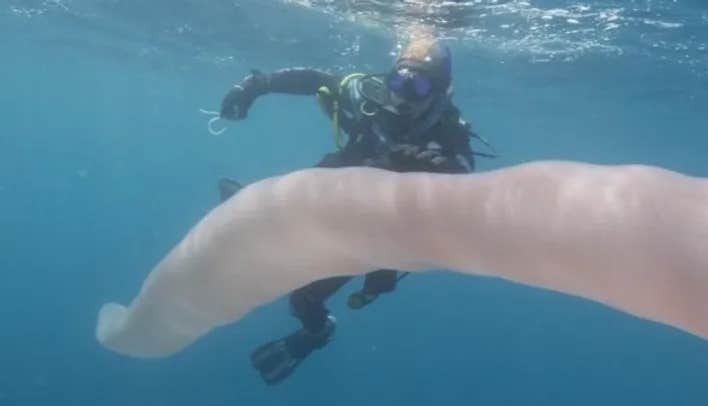Divers discover strange, 26-foot-long, giant sea worm
Discover the fascinating world of pyrosomes—glowing marine colonies vital to ocean ecosystems and a marvel of nature’s bioluminescence.

Two divers came across a spectacular sight while swimming off the coast of New Zealand. (CREDIT: Steve Hathaway)
Beneath the ocean’s surface lies a world teeming with creatures whose lives are as enigmatic as they are extraordinary. Among these is the pyrosome, a colonial organism made up of hundreds to thousands of tiny creatures called zooids.
Despite their gelatinous appearance, pyrosomes are not jellyfish but distant relatives of humans, linked by their place in the Chordata phylum, which includes animals with a notochord, a precursor to the backbone.
What Are Pyrosomes?
Pyrosomes are free-floating colonies of zooids, small multicellular organisms that work together to survive. These colonies range in size from a few centimeters to a staggering 60 feet in length, with some large enough for a human to swim through their hollow, cylindrical bodies.
Each zooid within the colony filters seawater to feed on microscopic plankton, bacteria, and other particles. The filtered water, expelled into the inner cavity, propels the colony through the ocean.
These organisms reproduce in two ways: asexually, to grow their colony, and sexually, to create new colonies. Found predominantly in open, pelagic waters, pyrosomes are essential to marine ecosystems. Their collective ability to filter vast volumes of seawater not only sustains their colonies but also plays a crucial role in ocean health.
When pyrosomes thrive, they can form blooms with thousands of colonies in one area. These blooms can impact ocean ecosystems significantly.
Upon death, the gelatinous bodies of pyrosomes sink rapidly to the ocean floor, creating a feast for benthic, or bottom-dwelling, marine life. This rapid sinking contributes to the marine carbon cycle, transporting organic material to the deep ocean.
Related Stories
Pyrosomes also play a pivotal role in oceanic food webs. Many marine animals, including sea turtles and spiny lobsters, rely on pyrosomes and their close relatives, salps, as a food source.
These gelatinous creatures are vital in tropical marine ecosystems, where their abundance supports various predators. However, their translucent, jelly-like bodies can also lead to fatal consequences when mistaken for plastic debris by marine animals.
Nature’s Living Lights
What truly sets pyrosomes apart is their bioluminescent ability. When disturbed, the zooids emit a mesmerizing glow that can be seen from a distance. This collective illumination, triggered by communication among the zooids, serves as both a defense mechanism and a visual spectacle.
These glowing tubes have captivated scientists and ocean enthusiasts alike. On Catalina Island, pyrosomes are rare but unforgettable visitors. Their arrival on the beaches, glowing in the moonlight, draws attention from researchers and curious onlookers.
“It’s incredible to see hundreds of thousands of tiny creatures working together in this way,” remarked one observer, describing the awe of swimming alongside a massive pyrosome.
Pyrosomes share a close relationship with salps, another type of gelatinous marine organism. Unlike pyrosomes, salps are solitary creatures made up of a single zooid. Both are classified as tunicates, colloquially known as "sea squirts" for their water-filtering abilities. Some even call them "sea cockroaches" for their resilience in nutrient-poor environments.
According to Andrew Jeffs, a marine science professor, pyrosomes and salps are not only abundant but also crucial food sources in tropical seas. Predators often take advantage of their slow movement, feeding on them over days or weeks. However, these creatures face threats from pollution, particularly plastic bags, which resemble their gelatinous forms.
A Rare Encounter
One memorable encounter involved a diver swimming around a massive 26-foot-long pyrosome. He described the experience as “incredible,” marveling at the intricate coordination of the tiny zooids within the glowing structure. Encounters like these highlight the pyrosome’s unique place in the marine world, where its otherworldly appearance often inspires curiosity and wonder.
These rare experiences also serve as opportunities to educate people about marine life. Educators like Steve Hathaway, a cinematographer, use footage of these creatures to engage young audiences. “It looks like a massive worm to them,” he said. “Sometimes it takes something unusual to make people stop and learn.”
Pyrosomes employ remarkable survival strategies. By swimming to the ocean surface at night, they capture phytoplankton under the cover of darkness, avoiding predators that feed during the day. As dawn approaches, they retreat to the depths, continuing their vital role in ocean ecosystems.
Despite their resilience, pyrosomes and their relatives face challenges. Climate change and rising sea temperatures may influence their distribution and population dynamics. Additionally, increasing marine pollution poses a growing threat to these fragile creatures.
The study of pyrosomes reveals much about the interconnectedness of ocean life. Their contributions to nutrient cycling, their role as a food source, and their bioluminescence offer insights into the complexity of marine ecosystems.
As rare and enigmatic as they may seem, pyrosomes remind us of the hidden wonders of the ocean and the importance of preserving its delicate balance.
Note: Materials provided above by The Brighter Side of News. Content may be edited for style and length.
Like these kind of feel good stories? Get The Brighter Side of News' newsletter.
Joseph Shavit
Head Science News Writer | Communicating Innovation & Discovery
Based in Los Angeles, Joseph Shavit is an accomplished science journalist, head science news writer and co-founder at The Brighter Side of News, where he translates cutting-edge discoveries into compelling stories for a broad audience. With a strong background spanning science, business, product management, media leadership, and entrepreneurship, Joseph brings a unique perspective to science communication. His expertise allows him to uncover the intersection of technological advancements and market potential, shedding light on how groundbreaking research evolves into transformative products and industries.



